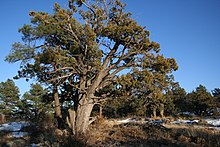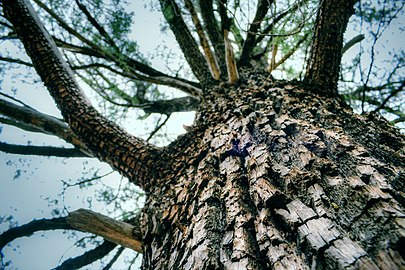bio.wikisort.org - Plant
Juniperus deppeana (alligator juniper or checkerbark juniper) is a small to medium-sized tree reaching 10–15 metres (33–49 feet) in height. It is native to central and northern Mexico and the southwestern United States.
This article needs additional citations for verification. (August 2022) |
| Juniperus deppeana | |
|---|---|
 | |
| Specimen in Gila County, Arizona | |
Conservation status | |
| Scientific classification | |
| Kingdom: | Plantae |
| Clade: | Tracheophytes |
| Clade: | Gymnosperms |
| Division: | Pinophyta |
| Class: | Pinopsida |
| Order: | Pinales |
| Family: | Cupressaceae |
| Genus: | Juniperus |
| Species: | J. deppeana |
| Binomial name | |
| Juniperus deppeana | |
 | |
| Natural range | |
Description
The tree reaches 10–15 metres (33–49 feet), rarely 25 m (82 ft), in height. The bark is usually very distinctive, unlike other junipers, hard, dark gray-brown, cracked into small square plates superficially resembling alligator skin; it is however sometimes like other junipers, with stringy vertical fissuring. The shoots are 1–1.5 millimetres (1⁄32–1⁄16 inch) in diameter. On juvenile specimens, the leaves are needle-like and 5–10 mm (3⁄16–3⁄8 in) long. The leaves are arranged in opposite decussate pairs or whorls of three; in adulthood they are scale-like, 1–2.5 mm (1⁄16–1⁄8 in) long (up to 5 mm) and 1–1.5 mm broad. The cones are berrylike, 7–15 mm (1⁄4–9⁄16 in) wide, green when young and maturing to orange-brown with a whitish waxy bloom,. These contain 2–6 seeds, which mature in about 18 months. The male cones are 4–6 mm (3⁄16–1⁄4 in) long, and shed their pollen in spring. The species is largely dioecious, producing cones of only one sex on each tree, but occasional trees are monoecious.
Taxonomy
There are five varieties, not accepted as distinct by all authorities:
- Juniperus deppeana var. deppeana. Throughout the range of the species. Foliage dull gray-green with a transparent or yellowish resin spot on each leaf; cones 7–12 mm (1⁄4–1⁄2 in) diameter.
- Juniperus deppeana var. pachyphlaea (syn. J. pachyphlaea). Arizona, New Mexico, northernmost Mexico. Foliage strongly glaucous with a white resin spot on each leaf; cones 7–12 mm diameter.
- Juniperus deppeana var. robusta (syn. J. deppeana var. patoniana). Northwestern Mexico. Cones larger, 10–15 mm (3⁄8–5⁄8 in) diameter.
- Juniperus deppeana var. sperryi. Western Texas, very rare. Bark furrowed, not square-cracked, branchlets pendulous; possibly a hybrid with J. flaccida.
- Juniperus deppeana var. zacatecensis. Zacatecas. Cones large, 10–15 mm diameter.
Etymology
Native American[clarification needed] names include táscate and tláscal.
Distribution and habitat

It is native to central and northern Mexico (from Oaxaca northward) and the southwestern United States (Arizona, New Mexico, western Texas). It grows at moderate altitudes of 750–2,700 m (2,460–8,860 ft) on dry soils.
Ecology
The berrylike cones are eaten by birds and mammals.[2][3]
Uses
Berries from alligator juniper growing in the Davis Mountains of West Texas are used to flavor gin, including one produced by WildGins Co. in Austin, Texas.[4]
References
- Farjon, A. (2013). "Juniperus deppeana". IUCN Red List of Threatened Species. 2013: e.T42231A2964728. doi:10.2305/IUCN.UK.2013-1.RLTS.T42231A2964728.en. Retrieved 12 November 2021.
- Little, Elbert L. (1994) [1980]. The Audubon Society Field Guide to North American Trees: Western Region (Chanticleer Press ed.). Knopf. p. 313. ISBN 0394507614.
- Whitney, Stephen (1985). Western Forests (The Audubon Society Nature Guides). New York: Knopf. p. 370. ISBN 0-394-73127-1.
- Elmer, Nicole L. (2020-01-09). "The Texas Eight: Love 'Em, Hate 'Em, or Drink 'Em". University of Texas at Austin Biodiversity Center. Retrieved 2021-04-15.
External links
- Adams, R. P. (2004). Junipers of the World: The genus Juniperus. Trafford Publishing ISBN 1-4120-4250-X
- Gymnosperm Database: Juniperus deppeana
- Flora of North America: Juniperus deppeana
- USDA Plant Profile: Juniperus deppeana
На других языках
- [en] Juniperus deppeana
[es] Juniperus deppeana
Juniperus deppeana es una planta de la familia de las cupresáceas. Es originaria de Norteamérica, desde el sur de Estados Unidos (Arizona, Nuevo México, Texas) hasta el oeste de Guatemala. Se conoce comúnmente como sabino o táscate.[ru] Можжевельник толстокорый
Можжеве́льник толстоко́рый (лат. Juniperus deppeana) — вид растений рода Можжевельник (Juniperus), семейства Кипарисовые (Cupressaceae).Другой контент может иметь иную лицензию. Перед использованием материалов сайта WikiSort.org внимательно изучите правила лицензирования конкретных элементов наполнения сайта.
WikiSort.org - проект по пересортировке и дополнению контента Википедии






